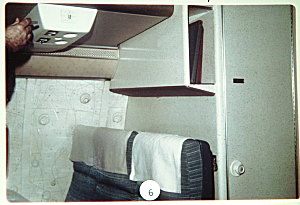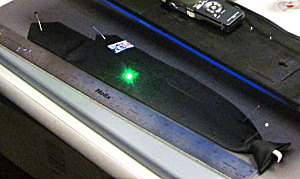|
The original owner of the tie is a point of continuing debate. The position of the FBI is that "we don't know if it's his tie." There is nothing that directly connects the tie to Cooper except for circumstantial evidence. Scientifically, when faced with a situation where there is no definitive proof, one must rely on statistical probability to give a "best estimate" of which answer is the most likely. Prior to this investigation, there were only two pieces of statistical evidence to link the tie to Cooper. 1. Cooper wore a black tie on to the plane, the tie found on the plane was black. Subsequently this investigation uncovered one additional piece of evidence. Methods There are three possible avenues where the tie could have come to rest on seat 18E. We 1. The tie belonged to a passenger or worker on one of the previous flights. A tie remaining on a seat from a previous flight would require the cleaning crew to miss it between flights. The flight attendants would also have missed it. Lastly Cooper would not only not seen it, but sat down on the knot with the protruding clip, and not feel it for the entire flight. The odds of all three, the cleaning crew, the attendants and Cooper missing the tie, is thought to be incredibly high and therefore this is probability is not included here. 2. The tie belonged to someone else on the plane. This is a viable possibility and needs to be included in the analysis. The odds increase against this being true because Cooper sat alone at the back of the plane. The passengers sitting in the three rows in front of Cooper were allowed to move further toward the front of the plane. There is testimony that some people went aft to go to the bathroom so he was not completely alone there through the entire flight. For this analysis we count all 36 passengers on the plane as male, minus the number of men wearing ties and females photographed leaving the plane. 3. The tie belonged to Cooper. This seems to be the most obvious conclusion, but the purpose of this analysis is to determine if any of the other passengers had a high probability of leaving a tie. In order for the tie to come to rest on the plane from some unknown passenger, a series of steps must take place as outlined below. 1. The passenger had a tie to remove. Additionally the unknown passenger had the following characteristics. 4. He smoked. For each of these five attributes we need to assign a probability for them being true. In some cases a probability could be assigned based on actual data, and others were based on reasonable assumptions. The odds attributed to each are outlined below. 1. Number of passengers potentially leaving a tie on Coopers flight including Cooper = 20 (36 total, 6 women on passenger list plus 10 men wearing ties when they exited the plane from 1971 video. A complete discussion of the math used to combine these probabilities is beyond the scope of this paper, but the Excel spreadsheet can be downloaded here. Discussion It would seem obvious that Cooper left his tie on his seat, but we must ask the question, how likely is it that any other passenger could have left the tie? Based on the probabilities given above, the chance a passenger on this flight that is a smoker with a black tie that would forget his tie on Cooper's seat is estimated to be 2%. Conversely, this puts the probability of the tie belonging to Cooper at 98%. This is better than a two sigma threshold which means that the value is statistically relevant if the probabilities are reasonable. Conclusions This analysis allows for a reasonable assumption that the tie belonged to Cooper. For purposes of discussion, the term "Cooper's tie" is therefore used throughout this research. Special thanks to Robert Crawford for this analysis. References 1. Surveillance for Selected Tobacco-Use Behaviors -- United States, 1900-1994. Center for Disease Control, 1994, Link
|

